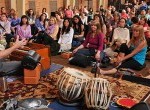As yoga becomes increasingly popular in the United States, the ancient practice of kirtan (KEER-tahn), or yogic chanting, is gaining interest. The call-and-response format of chanting is a type of yoga in itself and has many of the mind-calming benefits of a yoga class or sitting meditation.
For those who find meditation difficult, kirtan, which has varying effects for different people, offers the possibility for the same stillness of mind, without the struggle or striving to concentrate. This practice is one way to focus the mind. By simply repeating mantras or words, you can release your mind from its daily chatter. For some, the practice has a powerful heart-opening effect as well.
What Is Kirtan?
In the Yoga Sutras, one of the ancient, foundational yogic texts, Patanjali says the eight-limbed path consists of hatha, karma, bhakti, tantra, jnana, guru, mantra, and raja yogas.
Kirtan is a form of bhakti (BHAK-tee), the yoga of devotion; jnana (gyah-nah), the yoga of wisdom; and mantra, the yoga of sound. Mantras are words, phrases, and syllables that are repeated until they become integrated into the chanter’s consciousness. Today, many yoga students are discovering that this sacred, traditional practice allows them to access inner peace, calm, connection, and non-thinking.
This act of devotion originated some 2,500 years ago in India as a way for yogis to commune with God by chanting the names of the Divine, specifically Hindu gods and goddesses, such as Ram, Kali, Rama, Shiva, Durga, Krishna, and Lakshmi.
Kirtans were originally written in Sanskrit, the ancient Indian language. The Sanskrit alphabet has a strong energetic and vibrational component—it is said that the words, when chanted, create a powerful vibration in the body, affecting a person’s mind and spirit. In other words, no knowledge of Sanskrit is needed to receive and experience the yogic benefits of kirtan.
Perhaps you’ve experienced a taste of chanting in its most basic form: a group “om” at the close of a yoga class or the invocation prayer at the beginning of an Ashtanga or Jivamukti practice. These classes are often a yoga student’s first introduction to the power of mantra and can serve as an entryway into a deeper practice.
The Practice
Traditionally, kirtan is sung in a group with the kirtan walla, or chant leader, calling out words or phrases, which the audience repeats back in kind. The singing is often accompanied by a harmonium, a freestanding keyboard instrument that sounds similar to an accordion; drums, including classical Indian tablas; and additional rhythm instruments like bells and finger cymbals. Everyone is encouraged to join in.
While a gathering normally lasts a few hours, each song can last from 10 to 30 minutes, and unlike a musical performance, there is traditionally no applause between songs. Instead, a period of mindful silence follows each chant to allow the effects to settle in. The kirtan walla can deepen the experience by modifying the length of the chant, speeding up the pace or slowing it down. They sometimes build to ecstatic heights—similar to classical Indian ragas—bringing participants to their feet.
Perhaps the most famous American kirtan leader is Krishna Das, who is credited with introducing this transformative practice to the West. Many others have contributed to making kirtan what it is in the United States, including Deva Premal, Jai Uttal, Bhagavan Das, Russill Paul, Wah!, and Dave Stringer.
Deva Premal, who performs internationally with her partner Miten, was first exposed to chanting mantras while in her mother’s womb. “My father chanted the Gayatri Mantra to me through my mother’s pregnancy and during my birth,” she says. “I sang them daily for the first 10 years of my life. I rediscovered them when I was in my mid-twenties while singing with Miten.”
She says chanting is a spiritual practice for her: “Mantras carry intrinsic healing qualities . . . [something] you can only experience—words will always fall short.”
That sentiment resonates with kirtan-lover Alexandra Woods from Palm Coast, Florida. “I always tell people it’s like going to church. But what it really gives me is a sense of belonging with myself—not only with the world.”
Alexandra stumbled upon kirtan by accident. “I had a housemate in California who, every time I would ride in her car, would play kirtan songs. We would drive and sing along with her daughter Katrina. Then, when I went to the Satchinanda ashram is where I really got exposed.”
The Effects: Feeling the “Buzz”
Like other forms of yoga, kirtan is best understood through direct experience. People often say they feel bliss or “buzzed” after chanting. Justin Green, a massage therapist says, “I get so joyful…really blissfully happy, because it changes something. It opens me up. I think there is something inherently hypnotic about sharing voice, sharing breath, and moving, if we happen to be dancing. I think it breeds a sense of connection. It’s like praying together.” Justin adds, “At first I thought, ’What is this ridiculous stuff?’ I had a lot of resistance to it, but after the first one I was high. Then, I was hooked.”
“To someone who has not chanted before I would describe it as the very best way to become peaceful, to have a direct experience of the stillness inside,” says Paul Coggins, a movie-set designer. “It simply makes you happy and that can’t be bad, eh?”
Bhavani Lorraine Nelson, who leads chanting and meditation workshops at Kripalu says, “The most important thing when chanting is to have an intention, perhaps a personal intention of what you want to let go of in your life…if not, chant for the world.”
Whether it’s a sense of community, the joy of devotion, or the pure love of singing that draws you to kirtan, consider it another kind of yoga to explore this coming year. This celebratory practice allows us to go deep inside and connect to the divinity within us all.
Jennifer Mattson is a journalist, writer, yogini, and kirtan junkie. A former volunteer resident at Kripalu Center for Yoga & Health, she us a former broadcast news producer for CNN and National Public Radio. Her reporting and writing have appeared in TheAtlantic.com, The Boston Globe, USA Today and the Women’s Review of Books.


